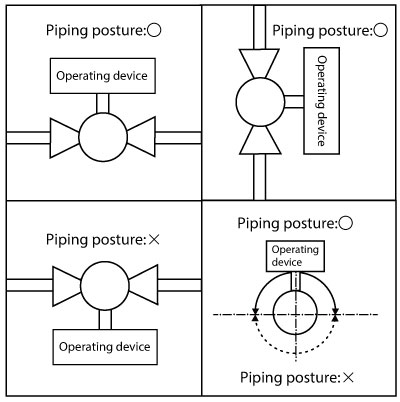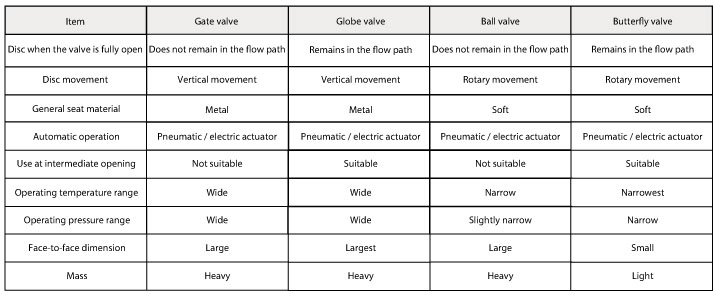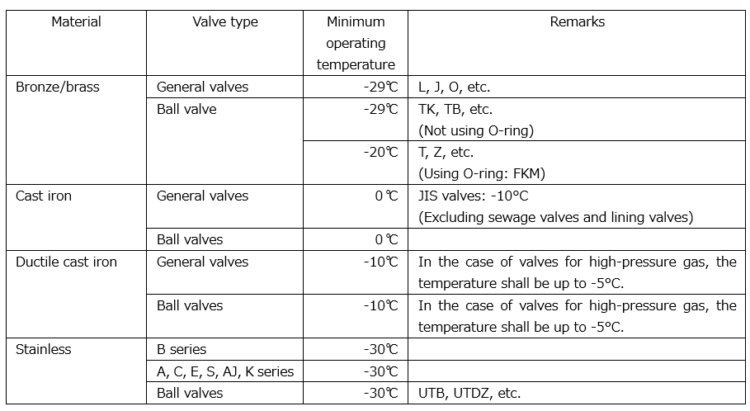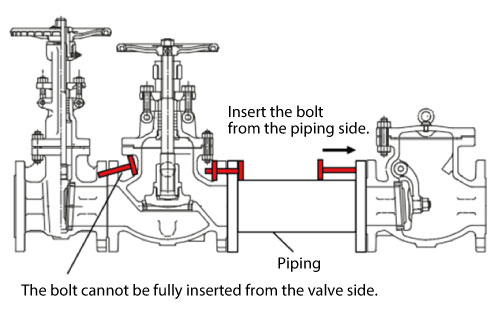General Questions
Installation posture
- Is it possible to install a valve with the top and bottom upside down?
-
Regarding the piping posture of the valve, it is not recommended to tilt the operating device (handle, gear operating device, pneumatic operating device, electric operating device, etc.) below the horizontal line. When the valve is tilted below the horizontal, foreign matter may accumulate in the gland part due to the effect of gravity. When the valve is opened and closed in this state, foreign matter may enter the packing due to the rotation of the stem, wear the packing and cause gland leakage. Therefore, please arrange the piping so that the operating device is above the horizontal as shown below.
Please refer to the FAQs below for restrictions on the piping posture and flow direction depending on the valve type.

・Is it possible to use a swing type check valve in vertical piping?
・Is it possible to use a lift type check valve in vertical piping?
・Is there any restrictions on the installation posture of a wafer type check valve?
・Is it possible to use a vertical lift type check valve horizontally?
・Tell me about the piping posture of a Y-strainer.
Product information
- What does “WOG” written on the handle represent?
-
“W, O and G” stand for Water, Oil and Gas.
* “Gas = Other than toxic and flammable gases”
- Tell me the approximate weights of the products.
-
The approximate weights of our products can be checked on our website.
They can be viewed by searching by model.
- Where can I get the product catalogs?
-
The product catalogs can be downloaded from our website.
- Where can I get product drawings?
-
The product drawings can be downloaded from our website.
The drawings can be downloaded by searching by model.
When viewing or downloading, please use it after user registration.
- How can I know the product delivery period?
-
Please contact your dealer for the delivery period.
- Where can I find the product price? In addition, what is the contact information when I want to get an estimate?
-
Please contact your dealer for the purchase price.
Please check the price list for the manufacturer’s suggested selling price.
- Where can I get the certificate of a RoHS compliant product?
-
Concerning the RoHS Directive, we manage the product as a product equivalent to the RoHS Directive.
As for the Certificate of Non-inclusion related to restricted substances of the RoHS Directive, you can down load the Regulated Substance Non-inclusion Report from our website.
When viewing or downloading, please use it after user registration.
- Is it possible to manufacture products with materials or processing that are not listed in the catalog?
-
We also handle custom-order products. Please contact your dealer for the range of manufacture.
- Where can I get the “Strategic Materials Non-Applicable Certificate” for a product?
-
“Security trade documents” can be issued from our website.
Please click “Security Trade Document Issuance Service” and download the certificate of the target product.
When viewing or downloading, please use it after user registration.
- Are there any precautions when installing valves or when using them?
-
Please refer to the precautions described in the instruction manual of each type of valve.
- Are there the SDSs (Safety Data Sheets) (former MSDSs) for valves?
-
We do not have SDSs for the valves themselves, but we have SDSs for the valve parts seats, paints, and coating agents used during assembly. So, please contact your dealer.
- Do you have valves that comply with the Food Sanitation Act?
-
The Food Sanitation Law does not apply to a valve alone, but it stipulates the prohibition of metals containing lead and/or antimony, and prohibition of structures where copper and/or lead can be scraped for devices, containers and packages.
SDSs are available for non-metallic resin and rubber soft parts used in valves, so please contact your dealer.
- What information is required for valve selection?
-
Basic information of “① Desired valve type, ② Connection method, ③ Size (nominal diameter), ④ Fluid operating temperature, ⑤ Fluid operating pressure, ⑥ Fluid name (including concentration and component values), ⑦ Material used for piping, etc.” is required.
In addition, please let us know the “use environment” and “application” as much as possible.
- What information should be communicated to identify a valve in the existing piping?
-
Since there is no product code described on the actual product, please contact your nearest sales office with “check items such as face distance, casted display, nameplate content” and, if possible, “images”.
- Regarding the structures of valves, tell me the characteristics of each valve type.
-
The characteristics of different valve structures are as follows.
Please select according to the method of use and piping environment.
- Tell me how to distinguish the trim materials of cast-iron valves.
-
The trim material of cast-iron valve is indicated by color on the nameplate.

- What does the casted “S” on a cast iron valve mean? (Example: “S” of “10K-150S”)
-
The casted “S” on the cast iron valve indicates that the seat structure of the disc is a threaded type.
- Tell me how to read the product code (FIG).
-
For how to read the product code, please check “Overview of KITZ Product Code System” in the general catalog digest version.
- Is it possible to get 3D CAD data?
-
We do not provide 3D CAD data, but we plan to prepare BIM data in the future.
Use condition
- The catalog says “Applicable fluids: Water, oil and gas.” Is it possible to use the valve with air as well.
-
Air can also be used, but please use the valve within the maximum allowable pressure of each product.
- Do you have valves with which the handle does not move up and down?
-
Gate valves with non-rising structure (inner screw type) and quarter-turn valves (ball valves, butterfly valves) are applicable.
- What is the purpose of opening the vent hole?
-
For gate valves and ball valves, when the fluid is liquid, a valve may be damaged due to increase of the internal pressure when the fluid is enclosed in the cavity part inside the valve casing when the valve is fully closed, and when it receives heat from the outside, or due to volume expansion that occurs when the fluid freezes. When such usage is known in advance, it is usually handled by providing a vent hole. However, note that the flow direction of fluid is restricted. Since globe valves have a structure without a cavity part, no vent hole is required.
- Is it possible to change the direction of the manual gear operating device in the field?
-
Basically, it is possible to change the direction of the operating device, but some products limit the direction that can be changed. Therefore, please contact your nearest sales office.
- The catalog says that the BC valves “can be used with water, oil and gas (other than flammable and toxic ones), but can they also be used with “light oil”, “kerosene” and “heavy oil”?
-
It is possible to use the BC valves and cast iron valves with light oil, kerosene, and heavy oil in terms of corrosion resistance. However, please note that these fluids fall under the category of hazardous materials in areas where the Fire Service Act is applicable, such as around oil tanks, and there are restriction on materials. Valves that can be used for hazardous materials are valves made of ductile cast iron, cast steel, and stainless steel. We recommend installing valves made of ductile cast iron or better even when installing in areas where the Fire Service Act is not applicable.
- What valves can be used for drinking water?
-
Please select from the valves for water supply provided by us or the products that passed inspection by the Japan Water Works Association, the products certified by the Certification Center or the products that conform to the lead leaching performance standards.
- Tell me the minimum operating temperature of valves.
-
The temperature varies depending on the product and use method, but rough guides for general products are as follows.
When the temperature is below these values, it may be handled with special specifications. Please identify the use conditions, such as fluid, temperature, and pressure, and contact your dealer.
When using at minus temperature, “no freezing of fluid” is an absolute condition.
- Is it possible to use bronze / brass valves for flammable gas?
-
Do not use bronze / brass valves for flammable gas or toxic gas. (The catalog clearly states that flammable gas and toxic gas are excluded.)
However, this does not apply to gas valves.Please refer to the catalog for gas valves.
(General Catalog, Digest Version_13-Gas)
Piping condition
- Is it possible to bury valves for piping?
-
We do not recommend to bury valves for installation. Prepare a valve box even when using a valve for burying.
- Is it possible to connect one valve to another valve directly for piping?
-
We do not recommend connecting the valves directly for piping.
Because of the valve structure, there is a possibility of interference as shown in the figure when passing bolts. Normally, a short pipe is sandwiched and the bolts are inserted from the pipe side, and the nuts are tightened on the valve side. Therefore, when installing a valve and a valve, be sure to use a short pipe to connect them for piping.
- Is it possible to connect a bronze valve to a stainless steel pipe?
-
Bronze and stainless steel are close in electrical potential, so they can be connected.
According to a material issued by the Japan Stainless Steel Association, it is described as “there is no practical problem.” However, please note that we do not recommend for brass valves.
- Tell me the dimensions of the bolts and nuts for piping of wafer type check valves.
-
Please refer to the catalog for the dimensions of the bolts and nuts for piping used for wafer type check valves.
(Wafer type check valves)In addition, the bolts / nuts for piping are attached to the product.
- Tell me the proper piping tightening torque for threaded products.
-
The proper piping tightening torque for threaded products are as follows.
Be careful not to tighten with excessive force.
Vacuum condition
- Do you have valves that can be used in a vacuum (negative pressure)?
-
Our products are designed on the premise of positive pressure and cannot maintain the degree of vacuum.
When used in a vacuum line, our products can be used in a range of low vacuum.* In the case of medium vacuum, our products will be available as an option. Please refer to the FAQs below.
・ Tell me the specifications of butterfly valves according to the degree of vacuum.
・ Tell me the specifications of ball valves according to the degree of vacuum.
* We consider 1 – 600 Torr as low vacuum and 0.001 – 0.1 Torr as medium vacuum as rough guides.Please refer to the table below for the amount of leakage.

Tell me the series of butterfly valves according to the degree of vacuum.
Tell me the specifications of ball valves according to the degree of vacuum.
Product purchase
- Where should I order to purchase the valve?
-
Please contact a dealer of pipe materials that has business with your company.
Maintenance
- Tell me the recommended timing for part replacement.
-
The part replacement timing depends on your use condition, environment and frequency of use.
Please perform daily and periodic inspections and check for damage, etc. of parts.
- Is it possible to purchase maintenance parts?
-
Since we sell maintenance parts, please contact your dealer for the scope of supply.
- Tell me how to replace the packing.
-
Please identify the product and refer to the disassembly/assembly in each instruction manual.
Terms
- What is the capacity coefficient (Cv value) of a valve?
-
The capacity coefficient of a valve indicates a “coefficient that represents the capacity of flow at a given travel under certain conditions.” (From JIS B 0100, Glossary of Terms for Valves)
It is a coefficient that expresses something like the performance that allows fluid to flow through a valve under specified conditions such as the valve opening degree and the pressure difference before and after the valve (differential pressure). The Cv value is often used as one of the capacity coefficients. The larger the Cv value, the easier the fluid to flow.
- What is water hammer?
-
Water hammer is a phenomenon in which the momentum of water in a water pipe changes in a short period of time and an abnormally large pressure wave is generated in the pipe. The cause is ① sudden opening / closing of the valve or ② sudden start / stop of the pump. When water hammer occurs, not only the valve may be damaged, but also the devices, etc. connected to the piping may be damaged. Therefore, it is necessary to pay attention to water hammer. As a countermeasure, close the valve as slowly as possible. Alternatively, we recommend that you consider a wafer type check valve or counterweight type check valve.
- Tell me the difference between gauge pressure and absolute pressure.
-
Gauge pressure is the pressure using the atmospheric pressure as the reference (0).
The unit display is G”, but it is often omitted.
The conversion formula from absolute pressure is [Gauge pressure = Absolute pressure – Atmospheric pressure].Absolute pressure is the pressure using an absolute vacuum pressure as the reference (0).
The unit display is A” or ”Abs”, but it is often omitted.
The conversion formula from gauge pressure is [Absolute pressure = Gauge pressure+ Atmospheric pressure].
